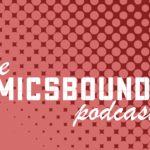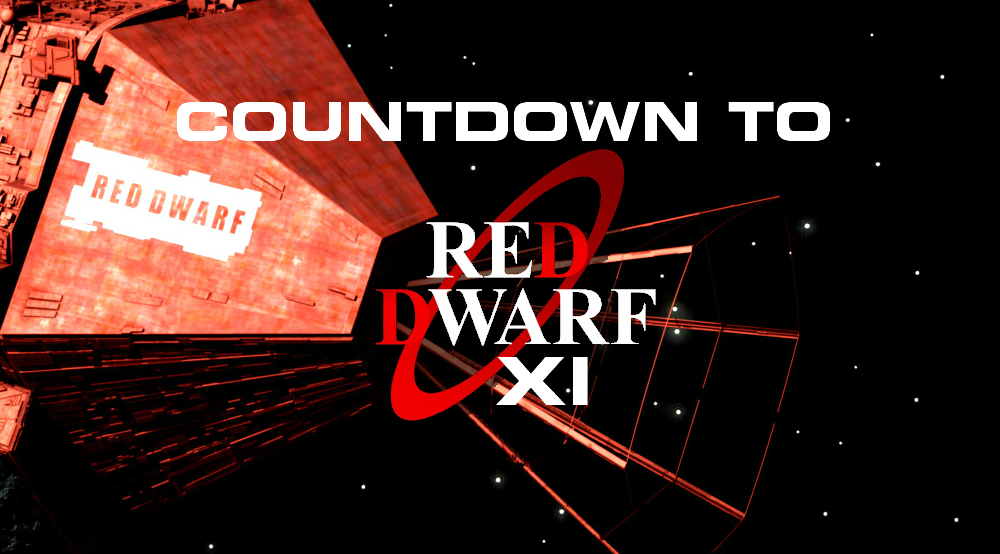
It’s hard to remember the value a dedicated magazine could bring to a fandom in a time before the internet. Unless you had a local group of friends who were into it with you, there was no outlet to broadcast your love for the show, no instantly accessible community. For twenty-three issues between 1992 and 1994, there was the Red Dwarf Smegazine ran interviews, articles, and discussion on Red Dwarf that kept its fanbase vitalized at a time when the show was performing at its peak. One of the most important features, however, present from the first issue to the last, were the comics.
There was no single author, artist, or even visual style consistent to the comics of the Smegazine. The publication gave creators freedom to explore aspects of the show the televised version never would. Stories take place in various series and focus on characters beyond the main five. The earliest comics were simple retellings of episodes. Both The End and Future Echoes were given the comic treatment, and while neither of these are my favourite comics the Smegazine produced, they established many of the aspects which would remain consistent enough for these anthology-esque comics to be identifiable as belonging together, such as the depiction of holograms as black and white. This was requested by Rob Grant and Doug Naylor, who always wanted to employ the prohibitively-expensive technique on the show.
It may not be Doctor Who or Star Trek, but comics provided a medium that matched Red Dwarf perfectly in terms of content. Facial expressions, body language, and background details like Rimmer’s soldiers from Marooned hidden in an adaptation of The End were a cheeky game between artist and fan, and the ability to take things to the extremes artistically made for an original take on the classic comedy. While retrospectively cheap looking in its publication and using only a few colours that come off as bold and brash, the style of the Smegazine comic still surpasses what you’d expect from a fan zine. There’s substantially more interesting visual storytelling going on than in a multi camera tv show, and the writing, coming from some of the most dedicated sci-fi fans out there, definitely held itself up to par.
Due to their nature, no two comics are stylistically the same. As such, it’s impossible to describe the Smegazine comics as a whole. The majority of the Red Dwarf Smegazine comics were written either by Steve Lyons, Chris Howarth, or Ann Wright, though a plethora of other writers contributed as well. They’re a densely packed treasuretrove of further entertainment for the desperate fan that are now freely available online. While it looks like there will be new Red Dwarf in the near future, it never hurts to be prepared. Here are a few of my personal favourite original stories or series.

-
Mutinous Pursuits
Written by Howarth/Lyons, Art by John Royle, Letters by Elitta Fell
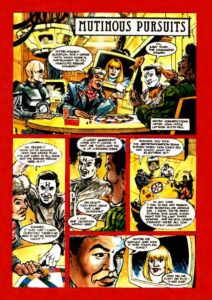 Mutinous Pursuits is the first original comic story featured in Smegazine. It picks up in Series IV with Kryten and Girl Holly as the gang is playing Trivial Pursuit. While it unfortunately repeats a few of the jokes from earlier seasons, it treats those jokes more as a set up to a later punchline than anything else. Rimmer’s feud with the skutters is used to great effect, and in the end it turns out everything was a distraction so Holly could rig the game so that she can use her total knowledge from “The Junior Encyclopedia of Space” and “Football: It’s a Funny Old Game” books to win.
Mutinous Pursuits is the first original comic story featured in Smegazine. It picks up in Series IV with Kryten and Girl Holly as the gang is playing Trivial Pursuit. While it unfortunately repeats a few of the jokes from earlier seasons, it treats those jokes more as a set up to a later punchline than anything else. Rimmer’s feud with the skutters is used to great effect, and in the end it turns out everything was a distraction so Holly could rig the game so that she can use her total knowledge from “The Junior Encyclopedia of Space” and “Football: It’s a Funny Old Game” books to win.
While Mutinous Pursuits doesn’t feel like quite enough material to warrant an entire episode, it does have that perfect tone for a light dose of comedy to break up the pages between interviews and news on the upcoming Red Dwarf USA. Not the best work the Smegazine would ever produce, but notable for being the first time Kryten was featured in the comic. His appearance is fairly easy for Royle to replicate in comic form, the hard angles of his head making an easy transition from screen to page.

-
Androids
Created by Kylie Gwenlyn
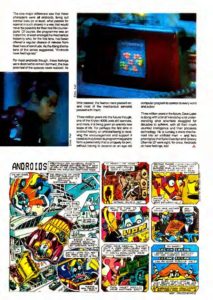 Kylie Gwenlyn’s Androids is a bit of an anomaly here. Rather than a one-off or multi-part comic like many of the others, it was a recurring strip styled as a simply laid out panel comic that presents itself as the soap opera from the episode Kryten.
Kylie Gwenlyn’s Androids is a bit of an anomaly here. Rather than a one-off or multi-part comic like many of the others, it was a recurring strip styled as a simply laid out panel comic that presents itself as the soap opera from the episode Kryten.
Like a newspaper strip to suit the soap opera format. These comics can get incredibly surreal and at times more superficially adult than I was expecting. I’d compare the Androids character design to the Metal Men from DC, with an absolute abundance of extreme angles and overextended limbs. It’s content, however, likely belongs somewhere like Mad Magazine. Sex, violence, betrayal, longing, and every other emotion you can imagine are here in short, frantic bursts. It’s a regular feature, but by its very nature, really never goes anywhere. Still, you can see why Kryten called it his favourite show.
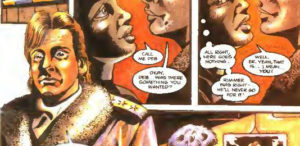
-
Ace Rimmer: Space Adventurer
Written by Howarth/Lyons, Art by Alan Burrows, Letters by Elitta Fell
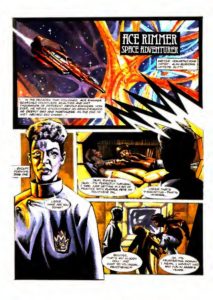 What a guy! As a concept, Ace Rimmer: Space Adventurer is one of the most brilliant comics in the entire magazine. With the space adventurer hopping between universes both known and new to the Red Dwarf fan, this particular story expands both the premise of Dimension Jump and Parallel Universe by returning to the gender-swapped universe of series 2. There are changes since we last visited. Not only do Lister and Rimmer now have a female mechanoid named Dayzee, but Hilly is now a man.
What a guy! As a concept, Ace Rimmer: Space Adventurer is one of the most brilliant comics in the entire magazine. With the space adventurer hopping between universes both known and new to the Red Dwarf fan, this particular story expands both the premise of Dimension Jump and Parallel Universe by returning to the gender-swapped universe of series 2. There are changes since we last visited. Not only do Lister and Rimmer now have a female mechanoid named Dayzee, but Hilly is now a man.
While this was the first Ace Rimmer comic to appear in the magazine, it wouldn’t be the last. Later comics in this series would see Ace visiting multiple alternate realities original to the comic. One particularly odd one is where his counterpart is a football player about to commit suicide. Ace gets in the game and kicks the old ball around. Dave, Kryten, and Cat all get parallel-universe cameos as well. Then another might see a universe where Rimmer is PM. Smoke him a kipper, he’ll be back for breakfast.

-
Whatever Happened to Duane Dibbley
Written and Art by Nigel Kitching, Letters by Elitta Fell
 Even the show couldn’t help bringing Duane Dibbley back a couple more times before the classic era of Red Dwarf ended in 1999. The Cat’s worst fear is that he’ll be considered uncool and Duane Dibbley is the universe’s number one dork. This comic serves as a direct sequel to Back to Reality, with Cat having a Despair Squid flashback that makes him think he’s actually Duane Dibbley.
Even the show couldn’t help bringing Duane Dibbley back a couple more times before the classic era of Red Dwarf ended in 1999. The Cat’s worst fear is that he’ll be considered uncool and Duane Dibbley is the universe’s number one dork. This comic serves as a direct sequel to Back to Reality, with Cat having a Despair Squid flashback that makes him think he’s actually Duane Dibbley.
A sequence at the end of this comic at first makes Rimmer seem cold and uncaring as the Cat is about to end his own life with a knife to his throat. The reveal that Cat was actually holding a herring the whole time makes for a great reveal, and I would have preferred something like this as the storyline that brought Duane Dibbley back in the show instead of Emohawk or Back in the Red. At the very least, it’d be interesting to see what Danny John-Jules could do for an episode on his own.
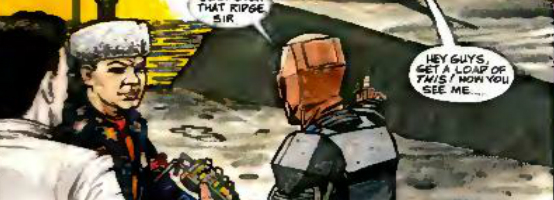
-
Heady Metal
Written by Steve Noble, Art and Letters by Jon Beeston
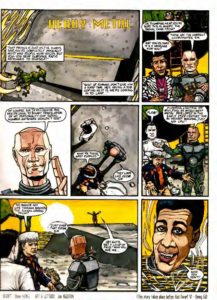 I’ve described the novels as being heavily influenced by Douglas Adams in their approach. The Smegazine book review section had multiple instances of The Hitchhiker’s Guide showing up. The fact that this story starts with Kryten receiving a message from himself and ends with Spare Head 3 completing the same time loop that Marvin the Android made is a great shout out. A little predictable, but a true space adventure. Spare Head 3 is abandoned on a planet of sentient metal called Flob that can be shaped by telepathic will. The boys (including Kryten) encounter Spare Head 3 after living for centuries in a world of his own creation.
I’ve described the novels as being heavily influenced by Douglas Adams in their approach. The Smegazine book review section had multiple instances of The Hitchhiker’s Guide showing up. The fact that this story starts with Kryten receiving a message from himself and ends with Spare Head 3 completing the same time loop that Marvin the Android made is a great shout out. A little predictable, but a true space adventure. Spare Head 3 is abandoned on a planet of sentient metal called Flob that can be shaped by telepathic will. The boys (including Kryten) encounter Spare Head 3 after living for centuries in a world of his own creation.
Where this story really shines is the visuals. Massive landscapes and statues to Kryten fill the landscape, and you can just imagine the nonlinear geometry that fills this world. While I don’t think the art totally captures the endless possibility of the concept, Jon Beeston gives some impressive visuals nonetheless.
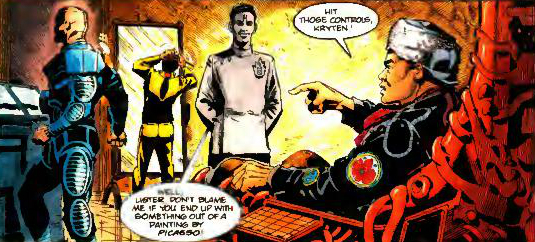
-
In Living Memory
Written by Steve Lyons, Art by Ron Smith, Colour and Letters by Elitta Fell
 Before Rimmer was granted hard-light status in series 6, the fact that he couldn’t touch or be touched by anyways was always a bit of a sticking point. That’s why the idea of creating a new body appealed to him so greatly. When the crew find a machine that can make anything you can imagine, Rimmer does that, exactly as he was, from memory. Of course, this is Rimmer we’re talking about, so that memory also makes him “Braver, stronger, and… erm, better endowed than before” to quote Kryten.
Before Rimmer was granted hard-light status in series 6, the fact that he couldn’t touch or be touched by anyways was always a bit of a sticking point. That’s why the idea of creating a new body appealed to him so greatly. When the crew find a machine that can make anything you can imagine, Rimmer does that, exactly as he was, from memory. Of course, this is Rimmer we’re talking about, so that memory also makes him “Braver, stronger, and… erm, better endowed than before” to quote Kryten.
Putting this comic in league with some of the other works in the magazine is no contest, but it contains shades of DNA in Rimmer’s plan. It’s a lark to see exactly how Rimmer sees himself and the way Ron Smith draws his live body with subtly different features works wonders to achieve this goal. Of course, like every time Rimmer gets his body back, something goes wrong, and as brave as he is, Rimmer sacrifices himself to the five-eyed amorphous blob Lister imagined and is killed by a pile of crumbling rocks.

-
Evolution
Written by Ann Wright, Art by Roger Langridge
 If nothing else, Evolution is interesting. It covers a concept the series would later address in the series 8 two-part episode Pete. Not only does the time wand feature prominently, but a plan to evolve something to its future state goes horribly wrong as the entire crew is devolved. Lister’s a monkey. Rimmer is a silent movie. Kryten is a vacuum cleaner. Cat is… well, do I even have to explain? Giving Talkie Toaster his own featured story along with Holly works incredibly well. Hattie Hayridge’s Holly is written very well by Ann Wright here. It feels a lot like their scenes in White Hole and it’s interesting to postulate what might have happened with that pairing.
If nothing else, Evolution is interesting. It covers a concept the series would later address in the series 8 two-part episode Pete. Not only does the time wand feature prominently, but a plan to evolve something to its future state goes horribly wrong as the entire crew is devolved. Lister’s a monkey. Rimmer is a silent movie. Kryten is a vacuum cleaner. Cat is… well, do I even have to explain? Giving Talkie Toaster his own featured story along with Holly works incredibly well. Hattie Hayridge’s Holly is written very well by Ann Wright here. It feels a lot like their scenes in White Hole and it’s interesting to postulate what might have happened with that pairing.
I likely wouldn’t have put this comic so high if it wasn’t for the art. It’s colourful. So many times a comic goes for realism and muted colours, but when it’s allowed to play around and be wacky and fun, I delight. Evolution has art that matches its premise.
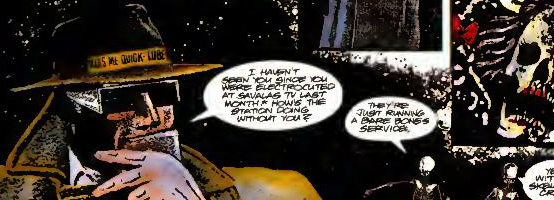
-
Jake Bullet: The Case of the Cashed-In Contestant
Written by Steve Noble, Art by Carl Flint, Letters by Woodrow Phoenix
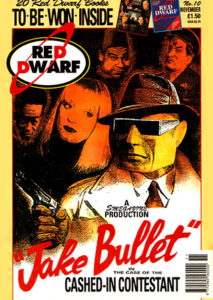 Like Duane Dibbley, Jake Bullet is a fictitious product of the Despair Squid, this time in the mind of Kryten. Unlike the Duane Dibbley comics, however, Jake Bullet: The Case of the Cashed-In Contestant indulges in all the trope-filled glory of England under fascist dictatorship. Carl Flint’s art has a unique visual style that goes gritty and subversive. These comics take on a film noir tone.
Like Duane Dibbley, Jake Bullet is a fictitious product of the Despair Squid, this time in the mind of Kryten. Unlike the Duane Dibbley comics, however, Jake Bullet: The Case of the Cashed-In Contestant indulges in all the trope-filled glory of England under fascist dictatorship. Carl Flint’s art has a unique visual style that goes gritty and subversive. These comics take on a film noir tone.
The penultimate comic sees Jake in an internal crisis, seeing shades of his self on Red Dwarf, questioning the nature of reality as he falls to his death. This is absolutely the darkest timeline for Red Dwarf, and the Jake Bullet comics don’t miss their chance to stay in that groove. The final issue of Jake’s serialized adventures has him being arrested. I’d love for this thread to be picked up one day by future writers.
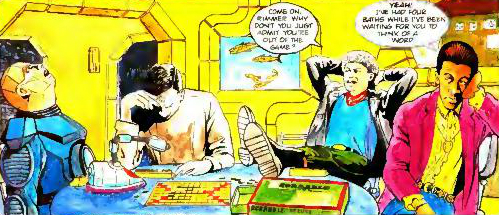
-
The Geap
Written by Ann Wright, Art by Vince Danks, Letters by Elitta Fell
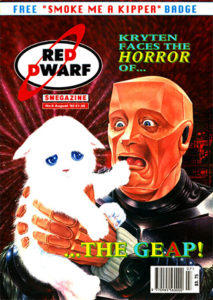 I chose this comic because it feels the most like an original episode of Red Dwarf without alterations. Clearly the creators of Smegazine thought so as well, as The Geap actually made cover status on the sixth issue. Inside a pod, the crew find an animal Kryten identifies as a G.E.A.P. (Genetically Engineered Adaptable Pet). He warns Dave that its telepathic influence will make humans love and protect them, but it has already awoken from stasis and taken Dave under its control. To add to the drama, Cat’s alien physiology makes him want to eat it.
I chose this comic because it feels the most like an original episode of Red Dwarf without alterations. Clearly the creators of Smegazine thought so as well, as The Geap actually made cover status on the sixth issue. Inside a pod, the crew find an animal Kryten identifies as a G.E.A.P. (Genetically Engineered Adaptable Pet). He warns Dave that its telepathic influence will make humans love and protect them, but it has already awoken from stasis and taken Dave under its control. To add to the drama, Cat’s alien physiology makes him want to eat it.
Vince Danks didn’t do art on many comics for the magazine, but his work on The Geap is wonderful. Incredibly colourful and original, he makes the adorable creature convincing as the object of Lister’s obsession. Those sad eyes? You can’t fight that. I want to hug it and I’m not even there.
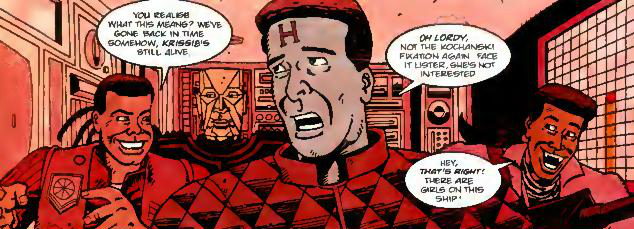
-
Home of Lost Causes
Script and Art by Nigel Kitching, Letters by Elitta Fell
 The story opens with the boys returning to Red Dwarf with an entire crew waiting for them. The fact that this comic predates the return of Red Dwarf to the show by nearly six years shows how genuinely inventive the Smegazine could be.
The story opens with the boys returning to Red Dwarf with an entire crew waiting for them. The fact that this comic predates the return of Red Dwarf to the show by nearly six years shows how genuinely inventive the Smegazine could be.
Pulling double duty as artist and writer for this comic, Nigel Kitching pushes himself to extremes. Kitching’s art is blocky and colourful, making the best of the comic experience by stylizing each character in full pop art glory. Kryten was flat-out made for this art style, and while Rimmer is still comics-true black and white, his puffy blue jacket is in full bold colour.
The imagery in this book is just as intense. Kristine Kochanski returns, and when Dave accidentally shoots her with a bazookoid, she continues talking with viscera and eyeballs splayed out of her head as she’s revealed to be a manifestation of the Polymorph. A version of Red Dwarf with a tail and gnashing teeth is one of my favourite depictions of the Polymorph, ramping the scale of the creature up from minor annoyance to genuine cosmic threat. While The Geap felt like the comics doing a true episode of Red Dwarf, Home of Lost Causes finally felt the comic doing something all its own.
Final Thoughts
While it may never have reached the status of Doctor Who or Star Trek in terms of having a vast comics library filled with continuity and complex original characters, Red Dwarf was always a series that prided itself on taking the smeg out of established sci-fi traditions. These comics maintained the cheeky subversive quality of the show and continued to give freedom to its creators. The fact that Smegazine noticed their importance, putting the comics on such a high pedestal within their publication that they often got cover status speaks volumes about their place in the minds of fans.
A final issue in January 1994 put a sudden end to Smegazine after only twenty-three issues. It was a start of a four year hiatus for the series and the end to its peak of popularity. With the launch of Series XI this week, it will mark the first time two series of Red Dwarf will air in back to back seasons since 1992 and 1993. It’s been a long road to get here. But it’s finally time. Finally, after all this waiting, the slime’s coming home.

